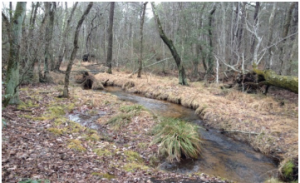Purchase and Development of Wetlands Property (PDF)
By Dan Caldwell, Principal, Stout & Caldwell Engineers, LLC – November 6, 2015
 Historically, wetlands were viewed as useless areas of land that were filled or used for refuse disposal. However, freshwater and coastal wetlands play a vital role in the functioning ecosystem providing a unique habitat for many species of flora and fauna, and also providing other important functions including enhancing water quality by removing nutrients and serving as storage for floodwaters.
Historically, wetlands were viewed as useless areas of land that were filled or used for refuse disposal. However, freshwater and coastal wetlands play a vital role in the functioning ecosystem providing a unique habitat for many species of flora and fauna, and also providing other important functions including enhancing water quality by removing nutrients and serving as storage for floodwaters.
To protect its integrity, wetlands are regulated at the Federal and State levels, and increasingly by many county and municipal agencies. The potential impact of wetlands upon a particular property’s value and development potential needs to be considered in all real estate transactions or development projects.
In general, specific to property purchase and development, wetlands should be looked at by employing
a three step process:
STEP 1 – IDENTIFICATION
Using the methodology established by the US Army Corps of Engineers, the presence, absence and/or limits of wetlands are identified and established. This is done through an extensive investigation of soils, vegetation and hydrologic indicators used in identification of wetlands. This investigation should be completed by a qualified individual with the proper training, familiarity and expertise employing proper
techniques to accurately evaluate a particular property specific to the presence of wetlands.
STEP 2 – VERIFICATION
Once areas of wetlands have been identified on a property, their limits (boundaries) should be verified by the respective overseeing governmental agency. Dependent upon a particular wetlands resource value, function, configuration and watershed affiliation, the extent to which particular wetlands area will be regulated can be established. In addition, as part of the verification process, establishment of upland transition areas (wetland buffers) are also made. Wetland buffers are also strictly regulated as
important parts to a functioning ecosystem and further protect the adjoining wetlands from adjacent
development activities.
STEP 3 – MANAGEMENT
The identification of wetlands on a particular property does not negate property value or prevent development. Rather the presence of wetlands is something which needs to be managed as part of the development process. A development design must take into account the areas of wetlands and their associated buffers. Wetlands and wetland buffers can further be managed through various
permitting options which may allow certain activities to occur within wetlands and wetland buffers. Early identification however is the key to the proper management of wetlands. This approach prevents the potential need for expensive project redesign and schedule delays.
Stout and Caldwell Engineers, LLC has the experience, technical expertise and familiarity with the
regulatory environment to successfully address wetland related issues and its potential impact upon your property or proposed project. We provide consultation for homeowners, developers, and prospective land buyers for simple and complex projects.

Dan Caldwell, Principal – Stout & Caldwell Engineers, LLC
705 US Route 130 South
PO Box 2290
Cinnaminson, NJ 08077
Phone 856-786-2202
Fax 856-786-3050
www.stoutcaldwell.com


